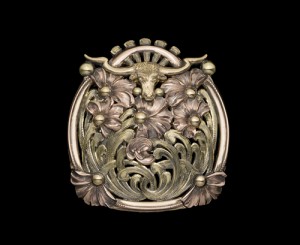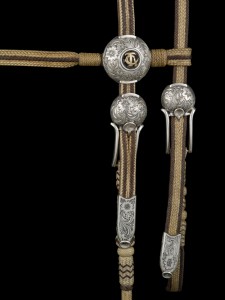Washington silversmith Mark Drain shares his insight
Silversmith Mark Drain’s career took root in Reno, Nevada, in the early 1970s, during the city’s heyday as a mecca for western craft. Influenced by iconic western craftsmen such as Al Pecetti, Fran Harry and Dan Murray, Drain became known for his custom buckles and saddle silver, and a style defined by boldness, balance and flow.
His work has since been exhibited throughout the United States, and is widely collected. A founding member of the Traditional Cowboy Arts Association, Drain, now based in Washington, is an emeritus member of the group and, among aspiring and veteran craftsmen alike, a sought-after instructor. Regardless of a buckle’s beginnings or intended market, Drain says, a great piece always begins with a sound visual concept. Here, Drain shares his insight on western buckle design.
Inspiration

Artists, Drain contends, find inspiration everywhere. His own influences and sources of ideas have included classic engraving, heavy machinery and Asian design concepts. A buckle maker, he suggests, should look both inside and outside the western culture for ideas about aesthetics and fabrication.
“I glean from everything,” he says. “Something as simple as a water faucet might have something about it that intrigues me. I pick up fabrication techniques from people who make flatware and jewelry. I look at Japanese sword guards for inspiration, and at trains and tractors, watches and tools. You don’t have to be a watchmaker or toolmaker to reproduce in whatever you’re doing that fineness and quality that you’ve seen.”
Originality
Once a concept for a buckle has begun to form, Drain says, a maker should work to develop an original approach to the project, a challenge for craftsmen in the tradition-steeped West. While he regards strictly traditional approaches as respectable ways of working, especially considering that some age-old techniques may already be lost, Drain says that after decades of making buckles, it’s the pursuit of originality that keeps his craft interesting.
“I’ve been making buckles for so long that I just can’t continue to make the same thing,” he says. “I don’t make spurs because I’d have to make one match the other. I don’t make bits because I’d have to make the cheekpieces match. I try to be as creative as I can be, figuring every way something can be made differently, rather than following the same old way. It’s like a game for me. I won’t make many more buckles in my lifetime. With those I do make, I want to introduce new concepts.”
Shape
Armed with an initial premise, a maker must zero in on the specifics that will define a buckle’s look, beginning with its basic shape.
“The first thing a person recognizes about a buckle is its outside shape, whether it’s an oval or a three-piece set,” Drain points out. “So the next thing I think about is the person the buckle’s for, and the buckle’s use. If it’s a trophy buckle, it likely needs to be a large oval. If it’s more for dress, it would likely be smaller, and could be a three-piece set.”
Focal Point

With the shape of the “palette” in mind, Drain says, a maker can then consider the buckle’s likely focal point – a figure, or perhaps a brand or set of initials, that will stand out on the face of the buckle, serving as its dominant feature.
“As with the outside shape of the buckle, you want the outside shape of that figure to stand out and be distinct,” Drain says. “A good rodeo figure, for instance, is usually viewed from the side so you can immediately tell if it’s a bull rider, a bronc rider or a roper. Brands and initials, of course, are more straightforward, but should still be crisp and distinct, and stand out.”
That dominant central element, Drain contends, should be in the center of the buckle – unless there’s a compelling reason to take a different approach.
“You see some buckles in which a brand is the most important feature,” he says, “but it’s stuck in a corner, with a flower in the opposite corner. Maybe the buckle’s owner valued both, but you need what’s important to be in the center.”
Anything else added to the face of the buckle, Drain contends, must complement that defining figure or set of characters.
Decoration
When it comes to adorning a buckle, a maker has endless options available – bright-cut vs. gun engraving, overlays, filigree work, use of color and more – but each design element should serve a purpose, contributing to the flow of the buckle by steering a viewer’s eye to the intended focal point. The scroll is among an engraver’s most effective ways of directing the viewer’s gaze.
“The first consideration with a scroll is where it originates – usually from the outside to the center of the buckle, and usually from a flower, as if coming from underneath that flower,” Drain says. “Scrolls, whether they’re engraved or overlaid, should be distinct enough that you can tell where they originate and where they’re going. They can be more interesting if you let them intertwine with other scrolls, but you want to avoid overcomplicating a buckle so much that a viewer can’t follow its flow.”
A buckle’s designer should ensure that each decision about decoration contributes meaningfully to the piece; such choices are not about merely filling space. For instance, filigree work, in which the background is removed, can serve to make figures more distinct; different colors of gold can be used to segregate features – “Red gold flowers, maybe, with yellow or green centers,” Drain suggests, “or initials in different colors of gold.”
Feel
“Every day, you put on clean clothes, but there are a few items you wear every day. A buckle is one of them,” Drain says. “You become attached to it, and it becomes a part of your identity.” Given its status in its wearer’s wardrobe, he adds, a buckle should have a feeling of substance to it.
“If you pick up a buckle and it’s light and thin, with sharp edges, it doesn’t have the feel of quality that a heavier buckle has,” Drain says. “If it has some weight to it, it has a richness. You’re confident it’s going to last.”
Drain adds that ornate buckles – and, for that matter, ornate saddle silver – deserve to be considered fine jewelry, a label that both the makers and wearers of such buckles should embrace.
Seeking Challenges
Drain sees an abundance of great design in the contemporary western culture, something he attributes to shows and other events fostering healthy competition among artists and craftsmen. Such competition encourages makers to experiment, to take on new challenges rather than fall back on familiar approaches or techniques. It’s a mindset that pushes Drain, after decades as a silversmith, to break new creative ground, to make each buckle’s creation something of an adventure. As a result, new goals are always in mind.
“I’d like to work more on surface texture,” Drain says. “Something that’s neat to look at, but not traditional bright-cut engraving. I don’t know what that will be yet, but I’m putting a lot of thought into it.”
This article originally appeared in issue #81 – Jan/Feb 2015 issue of Eclectic Horseman Magazine. Learn how to subscribe.
A.J. Mangum is the editor of Ranch & Reata magazine, and author of the non-fiction collection Undiscovered Country: Dispatches from the American West. Learn more at www.ajmangum.com.


